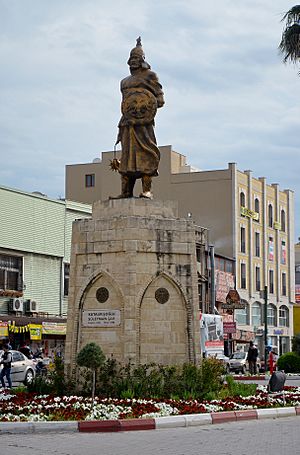Suleiman ibn Qutalmish facts for kids
Quick facts for kids Suleiman I |
|
|---|---|
| Shah Ghazi |
|

Kutalmışoğlu Suleiman monument in Tarsus, Mersin
|
|
| Sultan of Rum | |
| Reign | 1077–1086 |
| Predecessor | Qutalmish |
| Successor | Kilij Arslan I |
| Died | 1086 Near Antioch (modern-day Antakya, Hatay, Turkey) |
| Consort | Seljuka Khatun |
| Issue | Kilij Arslan I |
| House | Seljuk |
| Father | Qutalmish |
| Religion | Sunni Islam |
Suleiman I ibn Qutalmish (also known as Kutalmışoğlu Süleyman Şah) was an important leader. He started an independent Seljuk Turkish state in a region called Anatolia. He ruled as the Seljuk Sultan of Rûm from 1077 until he died in 1086.
Contents
Suleiman's Early Life and Challenges
Suleiman was the son of Qutalmish. His father had tried to become the ruler of the larger Seljuk Empire. However, Qutalmish lost this fight against his cousin, Alp Arslan.
When Qutalmish died in 1064, Suleiman and his three brothers had to escape. They went to the Taurus Mountains. There, they found safety with some Turkmen tribes. These tribes lived outside the Seljuk Empire's borders. Alp Arslan, the new ruler, sent armies to find them. Only Suleiman and his brother Mansur survived these attacks. Suleiman then became the leader of the Turkmen people.
How Suleiman Started His Own State
In 1075, Suleiman captured the city of Nicaea. This event is seen by some historians as the start of the Anatolian Seljuk State. Other historians believe it began a few years later, between 1078 and 1081.
After this success, the powerful Seljuk Sultan Malik-Shah I recognized Suleiman as a ruler in the region of Rûm. The Abbasid caliph Al-Qa'im also sent him a special order and a robe. This showed that they approved of his power. Even so, Suleiman was still connected to the larger Seljuk Empire.
Suleiman's Dealings with the Byzantine Empire
In 1078, the Byzantine emperor Michael VII faced a problem. A commander named Nicephorus Botaneiates wanted to take his throne. Emperor Michael VII asked Suleiman for help.
Suleiman met Nicephorus Botaneiates' small army near Cotyaeum and Nicaea. Nicephorus convinced Suleiman and Mansur to join his side. He offered them better rewards than the emperor. Nicephorus then became the new emperor. In return for their help, Suleiman's Turkmen people were allowed to live on the Asian side of the Bosphorus. This was very close to Constantinople, the Byzantine capital.
Two years later, Suleiman helped another person who wanted to be emperor, Nicephorus Melissenus. This Nicephorus opened the gates of Nicaea to the Turkmen. This allowed Suleiman to set up a lasting base there. Soon, the entire region of Bithynia was under Suleiman's control. This made it hard for Constantinople to communicate with its people in Anatolia.
Expanding His Territory
In 1084, Suleiman left Nicaea. He put his relative Abu'l Qasim in charge. That same year, Suleiman captured the city of Antakya (Antioch). He took control of the city and its valuable items. He also changed the main church into a mosque.
After Suleiman took Antakya, a ruler named Muslim ibn Quraysh from the Uqaylid dynasty demanded money from him. Suleiman refused to pay. This led to small battles along the border. In 1085, Muslim ibn Quraysh brought an army to attack Antakya. Suleiman met him and defeated Muslim. This happened after some Turkmen soldiers, led by Cubuk bey, left Muslim's army to join Suleiman.
Suleiman's Final Battle and Death
In 1086, Suleiman wanted to make his territory even bigger. He began to attack the city of Aleppo and demanded that it surrender. The leader of Aleppo sent a message to Tutush I, who was the Seljuk ruler of Syria. The leader said he would give the city to Tutush.
When Suleiman heard that Tutush's army was coming, he stopped attacking Aleppo. He marched to meet Tutush. In a battle called the battle of Ain Salm, near Aleppo, Suleiman attacked Tutush. However, Suleiman's forces ran away from Tutush's army, which was led by Artuk Bey. Suleiman was killed in this battle.
After Suleiman's death, Sultan Malik-Shah I went to Antakya. Suleiman's chief advisor surrendered the city and Suleiman's son, Kilij Arslan I, to Malik-Shah. Malik-Shah took Kilij Arslan to Isfahan as a hostage.
Later, after Malik-Shah I died, Kilij Arslan I was able to return. He then re-established the Sultanate of Rûm, continuing his father's legacy.
Images for kids
| Preceded by Qutalmish |
Sultan of Rûm 1077–1086 |
Succeeded by Kilij Arslan I |
See also
 In Spanish: Suleiman ibn Kutalmish para niños
In Spanish: Suleiman ibn Kutalmish para niños


